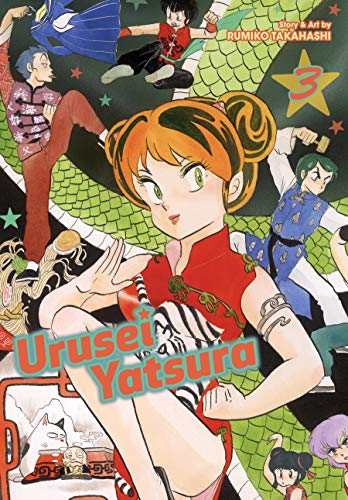By Rumiko Takahashi. Released in Japan in two separate volumes by Shogakukan, serialized in the magazine Shonen Sunday. Released in North America by Viz Media. Translated by Camellia Nieh.
After the soft reboot of this series with the arrival of Shutaro Mendo, Takahashi is going back and trying to see how she can work the pile of characters she introduced at the start back into the series, while also introducing new and hilarious regulars. Sometimes this works and sometimes it does not. The first half of this volume succeeds in re-integrating Sakura into the cast, now the high school nurse in addition to a shrine priestess, and we also meet Mendo’s rival Tobimaro Mizunokoji, a baseball-obsessed samurai type who is after revenge but is too dim to get it. (He’s also really obsessed with his childhood friend/rival, and has a passel of gorgeous female bodyguards that he barely pays attention to. I don’t think Takahashi intended him to have gay overtones, but…) Sakura will stay a regular, and Tobimaro will pop up now and then throughout the series. But not every new character is destined to become part of our beloved cast.
(The cover art, which has Ryuunosuke and her father; Sugar, Ginger and Pepper; and Kotatsu-neko – none of whom are introduced yet – is a tad spoilery. As are the endnotes, which discuss Ran before Ran is introduced.)
The second part of this volume seems like a series of failed cast introductions. Hanako-sensei is introduced to be a variation on the “well-meaning teacher who wants to inspire youth”, but he’s honestly pretty dang dull, and will quickly be replaced by Onsen Mark (who we’ve seen before) becoming a regular. (I will gloss right over Onsen Mark’s name in this omnibus, thanks much.) Natsuko’s volleyball-obsessed girl filled with rage is a very amusing arc, with great facial expressions, but she’s not someone you can imagine showing up over and over again. The same with Kaede the runaway ninja girl, who honestly seems like she’d be better off far away from Ataru and company. Fortunately, at the very end we meet Lum’s cousin and childhood “friend” Ran, who arrives with a cute act and a thirst for revenge, and is easily the best part of the back half of the book. You can see why she sticks around.
As for our regulars, they do pretty well. Ataru and Lum are fighting less, and frequently team up against common enemies (my favorite part being “Cry, Lum.” “Waaaaaaahh!” “See, you made her cry!”). Now, Lum still gets angry, and can be seen hear biting Ataru on the arm in addition to shocking him, but Ataru doesn’t seem to resent her presence anymore. Which is good, as she transfers into his school in this volume, thus helping to avoid finding reasons for her to show up in the classroom. The addition of the other cast members also helps take the focus of the manga off “will Ataru choose Lum” and focus more on “this obnoxious cast of obnoxious humans and aliens”, which will help it survive for the remaining fourteen omnibuses.
So there are some growing pains in this book, but it’s still highly entertaining, and Takahashi’s art has gotten to the point where you don’t have to apologize for it anymore. Still essential.





